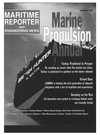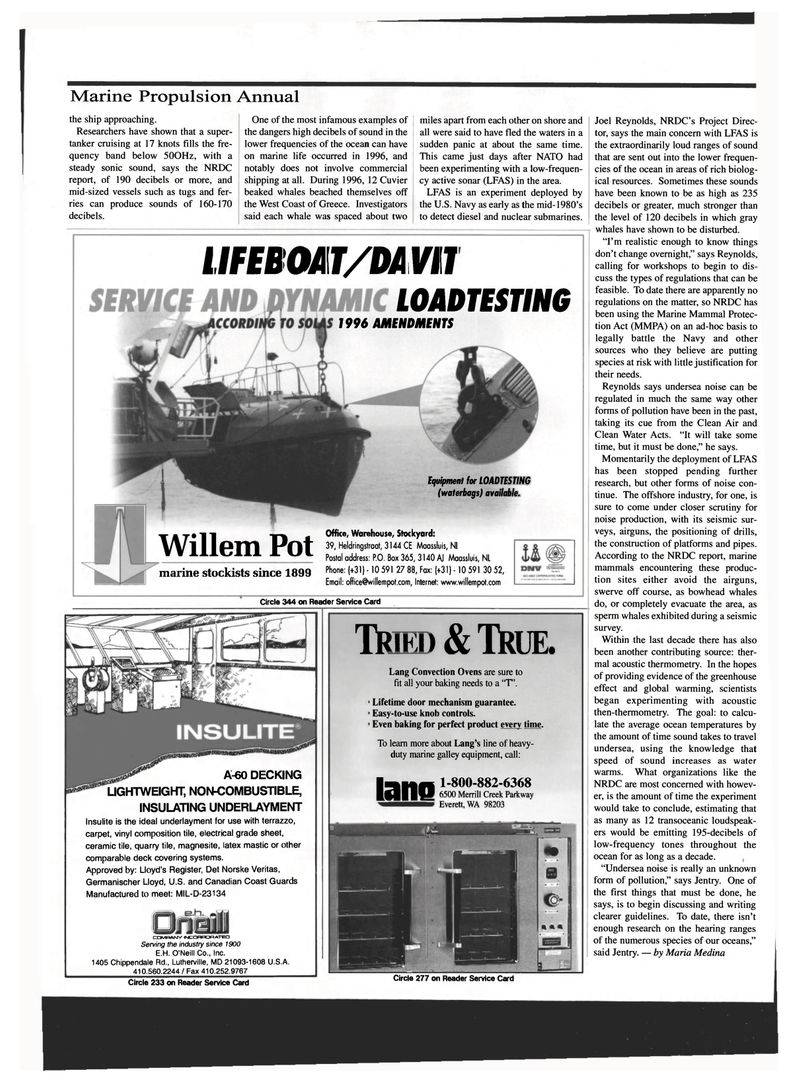
Page 86: of Maritime Reporter Magazine (September 1999)
Read this page in Pdf, Flash or Html5 edition of September 1999 Maritime Reporter Magazine
Marine Propulsion Annual the ship approaching.
Researchers have shown that a super- tanker cruising at 17 knots fills the fre- quency band below 500Hz, with a steady sonic sound, says the NRDC report, of 190 decibels or more, and mid-sized vessels such as tugs and fer- ries can produce sounds of 160-170 decibels.
One of the most infamous examples of the dangers high decibels of sound in the lower frequencies of the ocean can have on marine life occurred in 1996, and notably does not involve commercial shipping at all. During 1996, 12 Cuvier beaked whales beached themselves off the West Coast of Greece. Investigators said each whale was spaced about two miles apart from each other on shore and all were said to have fled the waters in a sudden panic at about the same time.
This came just days after NATO had been experimenting with a low-frequen- cy active sonar (LFAS) in the area.
LFAS is an experiment deployed by the U.S. Navy as early as the mid-1980's to detect diesel and nuclear submarines.
Joel Reynolds, NRDC's Project Direc- tor, says the main concern with LFAS is the extraordinarily loud ranges of sound that are sent out into the lower frequen- cies of the ocean in areas of rich biolog- ical resources. Sometimes these sounds have been known to be as high as 235 decibels or greater, much stronger than the level of 120 decibels in which gray whales have shown to be disturbed. "I'm realistic enough to know things don't change overnight," says Reynolds, calling for workshops to begin to dis- cuss the types of regulations that can be feasible. To date there are apparently no regulations on the matter, so NRDC has been using the Marine Mammal Protec- tion Act (MMPA) on an ad-hoc basis to legally battle the Navy and other sources who they believe are putting species at risk with little justification for their needs.
Reynolds says undersea noise can be regulated in much the same way other forms of pollution have been in the past, taking its cue from the Clean Air and
Clean Water Acts. "It will take some time, but it must be done," he says.
Momentarily the deployment of LFAS has been stopped pending further research, but other forms of noise con- tinue. The offshore industry, for one, is sure to come under closer scrutiny for noise production, with its seismic sur- veys, airguns, the positioning of drills, the construction of platforms and pipes.
According to the NRDC report, marine mammals encountering these produc- tion sites either avoid the airguns, swerve off course, as bowhead whales do, or completely evacuate the area, as sperm whales exhibited during a seismic survey.
Within the last decade there has also been another contributing source: ther- mal acoustic thermometry. In the hopes of providing evidence of the greenhouse effect and global warming, scientists began experimenting with acoustic then-thermometry. The goal: to calcu- late the average ocean temperatures by the amount of time sound takes to travel undersea, using the knowledge that speed of sound increases as water warms. What organizations like the
NRDC are most concerned with howev- er, is the amount of time the experiment would take to conclude, estimating that as many as 12 transoceanic loudspeak- ers would be emitting 195-decibels of low-frequency tones throughout the ocean for as long as a decade. "Undersea noise is really an unknown form of pollution," says Jentry. One of the first things that must be done, he says, is to begin discussing and writing clearer guidelines. To date, there isn't enough research on the hearing ranges of the numerous species of our oceans," said Jentry. — by Maria Medina
LIFEBOAT/DAVIT
LOADTESTING 1996 AMENDMENTS
Willem Pot marine stockists since 1899
Equipment for LOADTESTING (waterbags) available.
Office, Warehouse, Stockyard: 39, Heldringstraat, 3144 CE Maassluis, Nl
Postal address: P.O. Box 365, 3140 AJ Maassluis, Nl
Phone: (+31) -10 591 27 88, Fax: (+31) - 10 591 30 52,
Email: office§willempot.com, Internet: www.willempot.com
Circle 344 on Reader Service Card
A-60 DECKING
LIGHTWEIGHT, NON-COMBUSTIBLE,
INSULATING UNDERLAYMENT
Insulite is the ideal underlayment for use with terrazzo, carpet, vinyl composition tile, electrical grade sheet, ceramic tile, quarry tile, magnesite, latex mastic or other comparable deck covering systems.
Approved by: Lloyd's Register, Det Norske Veritas,
Germanischer Lloyd, U.S. and Canadian Coast Guards
Manufactured to meet: MIL-D-23134
CDMPANV INCORPORATED
Serving the industry since 1900
E.H. O'Neill Co., Inc. 1405 Chippendale Rd., Lutherville, MD 21093-1608 U.S.A. 410.560.2244 / Fax 410.252.9767
TRIED & TRUE.
Lang Convection Ovens are sure to fit all your baking needs to a "T". ' Lifetime door mechanism guarantee. 1 Easy-to-use knob controls. 1 Even baking for perfect product every time.
To leam more about Lang's line of heavy- duty marine galley equipment, call: lane 1-800-882-6368 6500 Merrill Creek Parkway
Everett, WA 98203
Circle 233 on Reader Service Card Circle 277 on Reader Service Card

 85
85

 87
87
